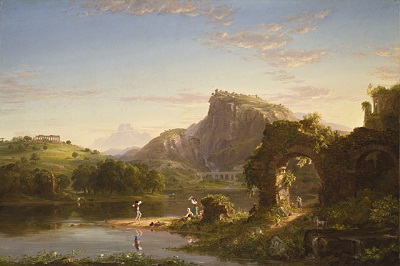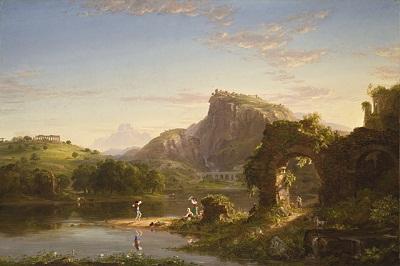One of the most memorable moments upon my first guard duty in the American art galleries in the Art of the Americas Building was the discovery of two paintings with "allegro" in their title, painted a hundred years apart, and apparently having little in common. Both Thomas Cole’s L’Allegro and Rolph Scarlett’s Allegro advantageously fit into the definitions of allegro: one being a mental state, the other a musical composition. And though broad schism would place one in the nostalgic pastoral era and the other in the futuristic abstraction era, there was to me a mysterious albeit strange affinity they both shared. For it was not the art of escape I found but rather one of re-idealization, a transcendental adventure of powerful aesthetic and politically moral European forces that were still able to cast a spell and direct the American artistic imagination. Once again I would find myself in the complex world of utopian romanticism and neoclassicism.

Thomas Cole, L’Allegro, 1845, gift of the Art Museum Council and The Michael J. Connell Foundation
In the early 1800s, Thomas Cole was a renowned romantic landscape painter whose vision and belief portrayed America as unbounded nature, an earthly paradise. He founded the Hudson River School, extending his belief in the divinity of American wilderness and biblical allusions to the hand of God and a promised land. His Catskill Mountains paintings captured the idealism of the new world, which of course was rapidly changing. Also, it was the age of revolution. An ardent romantic, Cole would travel to Europe and study the landscapes of Nicolas Poussin, Claude Lorrain, and Jacob van Ruisdael, some of which are present in the galleries on the third floor of the Ahmanson Building. While observing those works, I imagined the powerful effect that neoclassicism had on Cole’s ideas and its strange mixture with gothic Christian elements. I started to believe it was like having a new subject matter but still intensely about the same thing. For him, it would again and again be the sunrise and sunset, the intensely lit sky above a deep verdant greenery, aglow with white bleaching out the blue morning in a heavenly moment, while the soft residue of slim clouds, edged with gold strands of sunrays, disappear in the beyond. So to find Thomas Cole’s artistry tethered to the very lines of John Milton’s baroque verse is to imagine its profound effect. Greco-Roman ruins, a viaduct, and ancient costumed figures in Bacchus jollity “On the light fantastic toe” would give L’Allegro an unusually physical presence. To have learned the meaning of the title (“the happy man”), and then to have read the poem in which mirth and the very landscape, a neoclassic dream, which to me is made even more romantic in Thomas Cole’s beautifully realized setting, is to understand this painting and the powerful emotion underpinning its vision—to wed an orderly joyful past to a romantic Eden.

Rolph Scarlett, Allegro, c. 1944, gift of Fannie and Alan Leslie
Rolph Scarlett’s art is, mercifully, within the framework of my own experience, such that the impulses for his painting are largely hidden in my lack of understanding of him as a painter. On a search of his earlier work, I found he is clearly an abstractionist, though he would pass through several iterations. He was praised as a great colorist. Scarlett’s nonobjective painting was greatly inspired by a search for universal order. During the 1930s and 1940s, geometric abstraction became his key form of expression. The musical obsession of Wassily Kandinsky, a hero of Scarlett’s, had a profound influence on Scarlett’s art. And this is where I find that the cosmic order may have very well played against the backdrop of a world at war. Counterintuitively, Allegro attempts to capture order through a striking sense of music. The painting’s vertical rectangular bands, though in bright color, remind me of those slabs in Stanley Kubrick’s 2001: A Space Odyssey. Scarlett’s sense of space has a 3-D quality, where the circular celestial spheres, for me, are something symbolically prescient in his cosmic order. Musical tonality and scale imbue the strong colors, and one almost expects to hear their graduation from ruby red to crimson, ending in their pinkish hue or the pulsating purples and wines. A rhythmic beat is scattered in black holes with areolas of green that puncture the space. The non-geometrical backdrop rises in melodic smoke, a cloudy presence that leaches soft palettes of turquoise against a partial grey-and-black void that lies behind the colors. Rolph Scarlett conceived a cosmic composition of sheer dynamic form in perpetual motion— a painting as a sort of intergalactic leap of his transcendental longing into the mysticism of a musical score.
Hylan Booker



